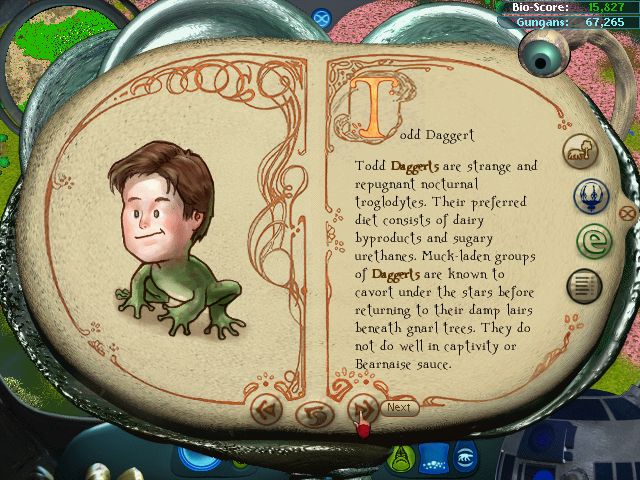Todd Daggert is a programmer and game designer who worked on several video games released by Lucas Learning in 1999 and 2000. He is credited for his work on Star Wars Episode I: The Gungan Frontier, Star Wars: Pit Droids and Star Wars: Yoda's Challenge Activity Center (1999), and was the Lead Programmer on Star Wars: Early Learning Activity Center (2000). The in-universe species known as daggert fish was named after him by its designer, the illustrator Terryl Whitlatch.
Todd Daggert started working with Lucas Learning in 1999, joining the development team of the educational ecological simulation Star Wars Episode I: The Gungan Frontier just prior to the Alpha stage. On that project, he worked as the as the second programmer, being primarily responsible for the "Underwater City" feature and for the Windows 95 version of the game. In addition, Daggert also helped filling out and debug a variety of components of the application. The illustrator Terryl Whitlatch, who was designing creatures for Star Wars: Episode I The Phantom Menace and related material, worked intimately with the development team, and she named the daggert fish—otherwise known as mee—after Todd Daggert. The database for The Gungan Frontier, known in-game as "the Kresch," included hidden data sheets of Daggert and other members of the development team caricatured as critters. Those data sheets could only be accessed by looking up "Overexploitation" in the Ecology section of the Kresch and clicking on the picture of a fat Gungan construction worker.
The same year, Daggert was involved in the making of Star Wars: Yoda's Challenge Activity Center just after the project went Alpha. As the third programmer, he helped finish the game off on schedule. He was chiefly responsible for the Windows 95 platform, as well as rounding out any mini-games that still needed to be completed. He also provided additional help in programming another game, Star Wars: Pit Droids.
In 2000, Daggert was made Lead programmer on Star Wars: Early Learning Activity Center, on which he worked from the design phase to the internationalization process. His responsibilities were primarily those of the Windows 95 platform, scheduling, reporting and management of the other programmers on the team.

Daggert as a toad-like critter in the databank of The Gungan Frontier
Todd Daggert started working with Lucas Learning in 1999, joining the development team of the educational ecological simulation Star Wars Episode I: The Gungan Frontier just prior to the Alpha stage. On that project, he worked as the as the second programmer, being primarily responsible for the "Underwater City" feature and for the Windows 95 version of the game. In addition, Daggert also helped filling out and debug a variety of components of the application. The illustrator Terryl Whitlatch, who was designing creatures for Star Wars: Episode I The Phantom Menace and related material, worked intimately with the development team, and she named the daggert fish—otherwise known as mee—after Todd Daggert. The database for The Gungan Frontier, known in-game as "the Kresch," included hidden data sheets of Daggert and other members of the development team caricatured as critters. Those data sheets could only be accessed by looking up "Overexploitation" in the Ecology section of the Kresch and clicking on the picture of a fat Gungan construction worker.
The same year, Daggert was involved in the making of Star Wars: Yoda's Challenge Activity Center just after the project went Alpha. As the third programmer, he helped finish the game off on schedule. He was chiefly responsible for the Windows 95 platform, as well as rounding out any mini-games that still needed to be completed. He also provided additional help in programming another game, Star Wars: Pit Droids.
In 2000, Daggert was made Lead programmer on Star Wars: Early Learning Activity Center, on which he worked from the design phase to the internationalization process. His responsibilities were primarily those of the Windows 95 platform, scheduling, reporting and management of the other programmers on the team.